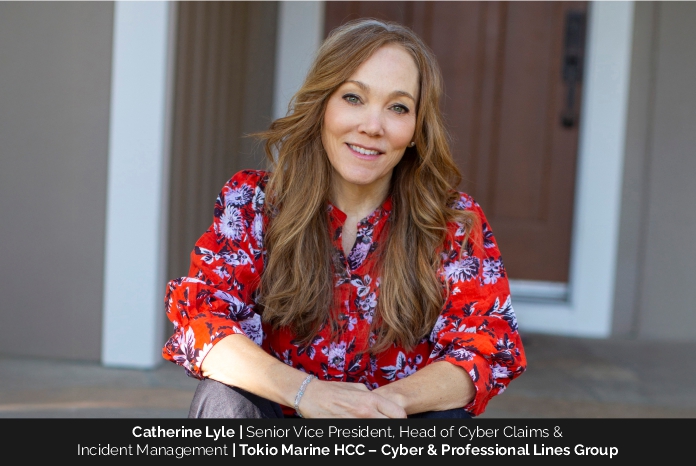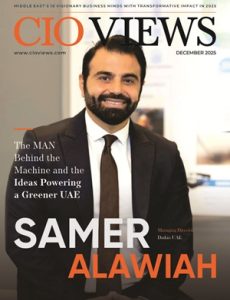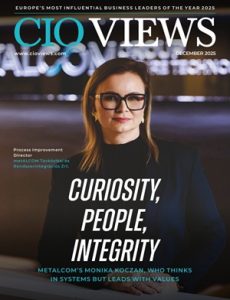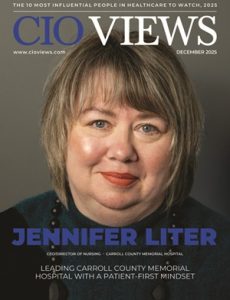“Cyber insurance will no longer just be a financial backstop”. This is one of the striking predictions from Catherine Lyle, Senior Vice President and Head of Cyber Claims and Incident Management at Tokio Marine HCC – Cyber & Professional Lines Group, a member of the Tokio Marine HCC group of companies based in Houston, Texas (CPLG).
Discussing industry transformation, she believes its future lies in becoming a partner in prevention for companies and individuals. “Policies,” Catherine anticipates, “will become smarter, more data-driven and more tailored to specific risks.” That’s not all! The cyber insurance model will mature into a more integrated and aligned system among insurers, cybersecurity providers, and customers.
The Moment Everything Changed
Catherine’s penchant for cyber insurance is not something she stumbled into. She was drawn to this sector as it sits at the intersection of risk, technology, and resilience. These are three areas that she has always found both challenging and deeply impactful.
In the initial stages of her career, she witnessed how devastating a single “cyber” incident could be for a business, both from a financial perspective and a reputational one. That experience was her turning point. It demonstrated the importance of preparing businesses and individuals against these types of threats.
Given she was already working in the insurance sector, she examined how it could do more than just transfer risk. Her research focused on how insurance could also be a catalyst for change in corporate behavior through the adoption of technology. This approach, she found, not only provided a safety net but also reinforces resilience and drives systemic improvement. What is the most exciting part of working in this field? For Catherine, it is both helping businesses and individuals recover from risk and helping them prevent, adapt, and become stronger because of it.
The Moment She Saw Things Differently
Behind her inclusion in “The 5 Visionaries Redefining Insurance in 2025” is Catherine’s persistent foresight. Although her professional journey has included many important moments, one kairos stands out above the rest: her tenure at a traditional insurance carrier.
The company’s approach to cyber insurance was very limited. Instead of thoroughly analyzing and underwriting cyber risks, they were mainly assessing policies based on the amount of PII (personally identifiable information) a company held. Catherine’s immediate thought was that unless this approach or mindset changed, the industry would not succeed.
“Cyber risk is far more complex than the volume of data a company maintains,” she explains. Being static is only costly in a constantly evolving threat domain. It made her recognize that incident management and leadership practices must evolve as well. The episode taught her never to depend on outdated models or narrow perspectives. Instead, question them, anticipate what’s next. The most important takeaway? To align what they do with the realities of the world that clients face.
Tricky Cyber Claims Challenges
Cyber claims are replete with challenges. Many of them pop up from unexpected grounds. When queried regarding the most perplexing, Catherine indicated those involving non-profit organizations derived complexity. These entities often do admirable, cause-driven work. However, when cyber adversities attack, the aftermath can be detrimental.
The reasons are simple. Resources of non-profit organizations are limited. Plus, they are heavily relied upon by their communities. Besides technical expertise, empathy and creativity are required to help non-profits through these cyberattacks. This combined approach, Catherine notes, allows them to find solutions that enable recovery and continuation of their vital missions.
Ultimately, success stems from building trust with clients and partners alike, regardless of the organization’s scale or nature.
Proudest Achievement
Catherine is most proud of building a claims and incident response framework, including recovery of stolen funds, that has become a benchmark across the industry. This process is a critical part of responding to malicious cyber incidents. She points out that these incidents can be devastating for clients, and the loss goes far beyond money. Operational processes may stop. The organization’s reputation may take a downward turn. On top of that, the emotional toll on teams can also be severe.
Recovering stolen funds from malicious hacks is a taxing method. For some firms, bouncing back is relatively unscathed. Others find the financial and reputational fallout too huge to withstand. Catherine indicates that for specific clients, this means meeting payroll, keeping the lights on, or reestablishing trust with customers and partners. By putting in place a framework that prioritizes fast action and close collaboration with banks, law enforcement, and forensic experts, Catherine and her team have been able to speed up recovery efforts. The approach gives clients hope and delivers tangible relief during some of their darkest moments. Beyond helping individual companies, it has shown how insurers can strengthen cyber resilience and set an example for the industry with fast, coordinated, client-focused responses.
Listening First, Innovating Fast
“Innovation for me starts with listening,” Catherine asserts. It involves listening to clients, the market, and the ever-evolving threat arena. From there, under her supervision, her team introduces and integrates new technologies and processes with internal data. This entire practice helps them stay up-to-date.
Cybersecurity and Insurance Leadership with a Vision
Visionary leadership to Catherine means anticipating tomorrow’s risks while building solutions today. Catherine fulfils her role by combining strategic foresight to bring CPLG forward while remaining realistic so that her approaches ensure that not only does CPLG stay ready for tomorrow, but also that their clients don’t suffer during the process.
Maintaining Energy and Perspective in a High-Stakes Environment
Outside of work, Catherine finds balance in the simplest details of life. It includes, backpacking, running, family time, or just the simple action of stepping outside. Vacationing with her closest people helps her reset her perspective and see life without the eyes of a professional. That sense of balance helps her keep her mind crystal clear and focused when work pressure hits.
Collaborative Leadership Edge: Influencing The Generation Next
Every leader has a leadership style. Catherine’s style is to put people first. She is one of those whose approach allows others to feel involved and have a stake in the result. She is known for sparking creativity in everyone around her.
Catherine’s leadership rests on trust, shared accountability, and transparency. The veteran sees collaboration as a mode to bring out the best in people, helping them grow and take ownership. When people feel empowered and supported, professional wonders happen. They push boundaries, acquire new skills, and achieve lasting outcomes.
Catherine aims to have her work influence future generations of professionals in cyber insurance and risk management. “I believe the greatest influence comes not only from the frameworks we build, but from the culture we create,” she reflects. She hopes future generations will see what she leaves behind as real change. To her, that culture of collaboration does more than solve today’s problems. It builds the foundation for long-term resilience and innovation.
Advice for the Aspirants
For aspiring leaders in insurance and cybersecurity, Catherine has some fantastic advice. It all starts with curiosity. This field is brimming with challenges. To sustain and flourish here, the aspirants must embrace complexity. She advises, “Remember to stay grounded.” She continues, “The work is serious and intense, but keeping perspective makes you approachable and effective for everyone counting on you.” In other words, lead with curiosity, humility, and heart to leave an indelible mark.
Leadership, to this experienced executive, hits three key notes. It creates clarity when everything feels murky. It offers the stamina to ensure longevity. Plus, it furnishes the strength at the base, so great things can be successfully built upon what she has started.





